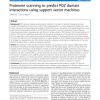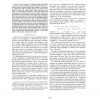62 search results - page 6 / 13 » Improved prediction of trans-membrane spans in proteins usin... |
BMCBI
2010
13 years 7 months ago
2010
Background: PDZ domains mediate protein-protein interactions involved in important biological processes through the recognition of short linear motifs in their target proteins. Tw...
ISMB
2000
13 years 8 months ago
2000
Knowing the number of residue contacts in a protein is crucial for deriving constraints useful in modeling protein folding, protein structure, and/or scoring remote homology searc...
BMCBI
2006
13 years 7 months ago
2006
Background: We describe Distill, a suite of servers for the prediction of protein structural features: secondary structure; relative solvent accessibility; contact density; backbo...
IJCNN
2008
IEEE
14 years 1 months ago
2008
IEEE
— Fuzzy Associative Conjuncted Maps (FASCOM) is a fuzzy neural network that represents information by conjuncting fuzzy sets and associates them through a combination of unsuperv...
BMCBI
2008
13 years 7 months ago
2008
Background: Prediction of transmembrane (TM) helices by statistical methods suffers from lack of sufficient training data. Current best methods use hundreds or even thousands of f...


